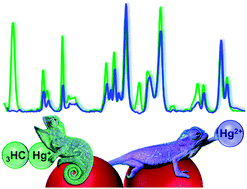Chemical speciation of heavy metals by surface-enhanced Raman scattering spectroscopy: identification and quantification of inorganic- and methyl-mercury in water†
Abstract
Chemical speciation of heavy metals has become extremely important in environmental and analytical research because of the strong dependence that toxicity, environmental mobility, persistence and bioavailability of these pollutants have on their specific chemical forms. Novel nano-optical-based detection strategies, capable of overcoming the intrinsic limitations of well-established analytic methods for the quantification of total metal ion content, have been reported, but the speciation of different chemical forms has not yet been achieved. Here, we report the first example of a SERS-based sensor for chemical speciation of toxic metal ions in water at trace levels. Specifically, the inorganic Hg2+ and the more toxicologically relevant methylmercury (CH3Hg+) are selected as analytical targets. The sensing platform consists of a self-assembled monolayer of 4-mercaptopyridine (MPY) on highly SERS-active and robust hybrid plasmonic materials formed by a dense layer of interacting gold nanoparticles anchored onto polystyrene microbeads. The co-ordination of Hg2+ and CH3Hg+ to the nitrogen atom of the MPY ring yields characteristic changes in the vibrational SERS spectra of the organic chemoreceptor that can be qualitatively and quantitatively correlated to the presence of the two different mercury forms.


 Please wait while we load your content...
Please wait while we load your content...